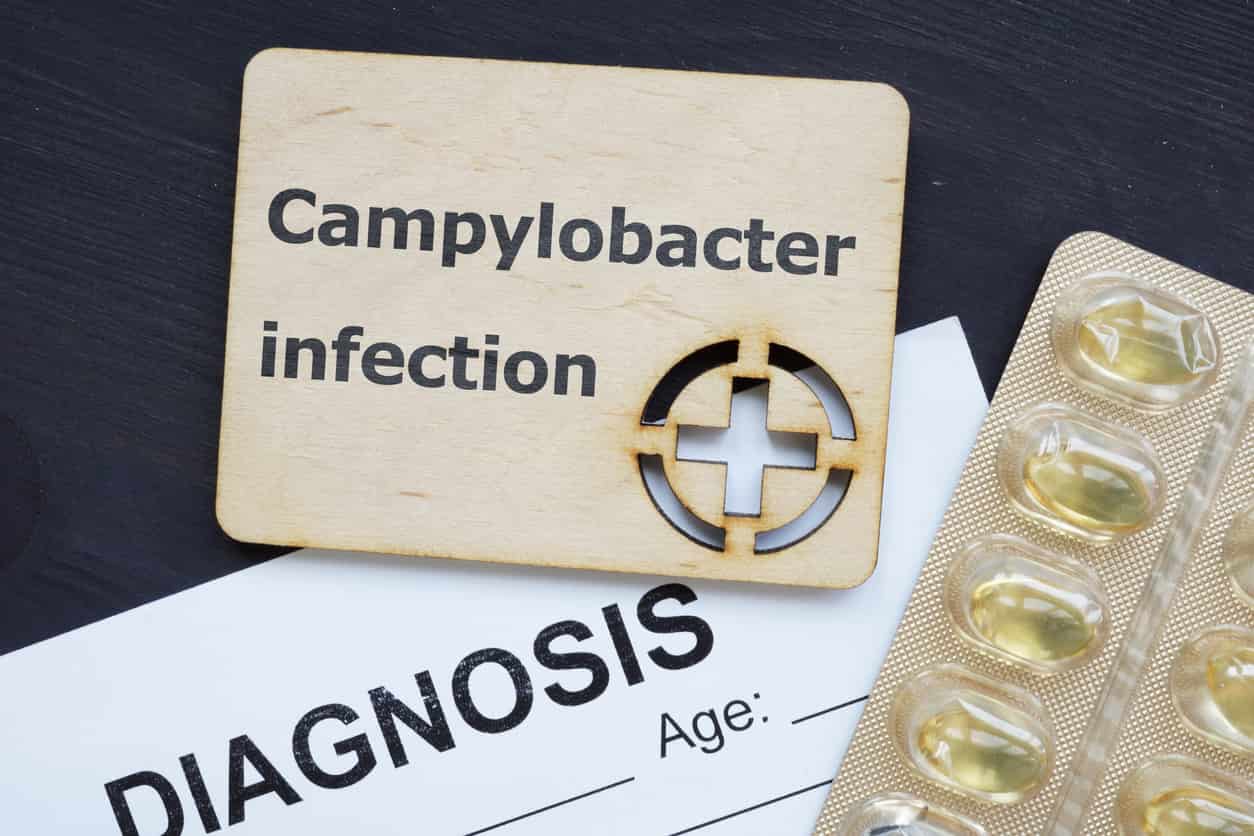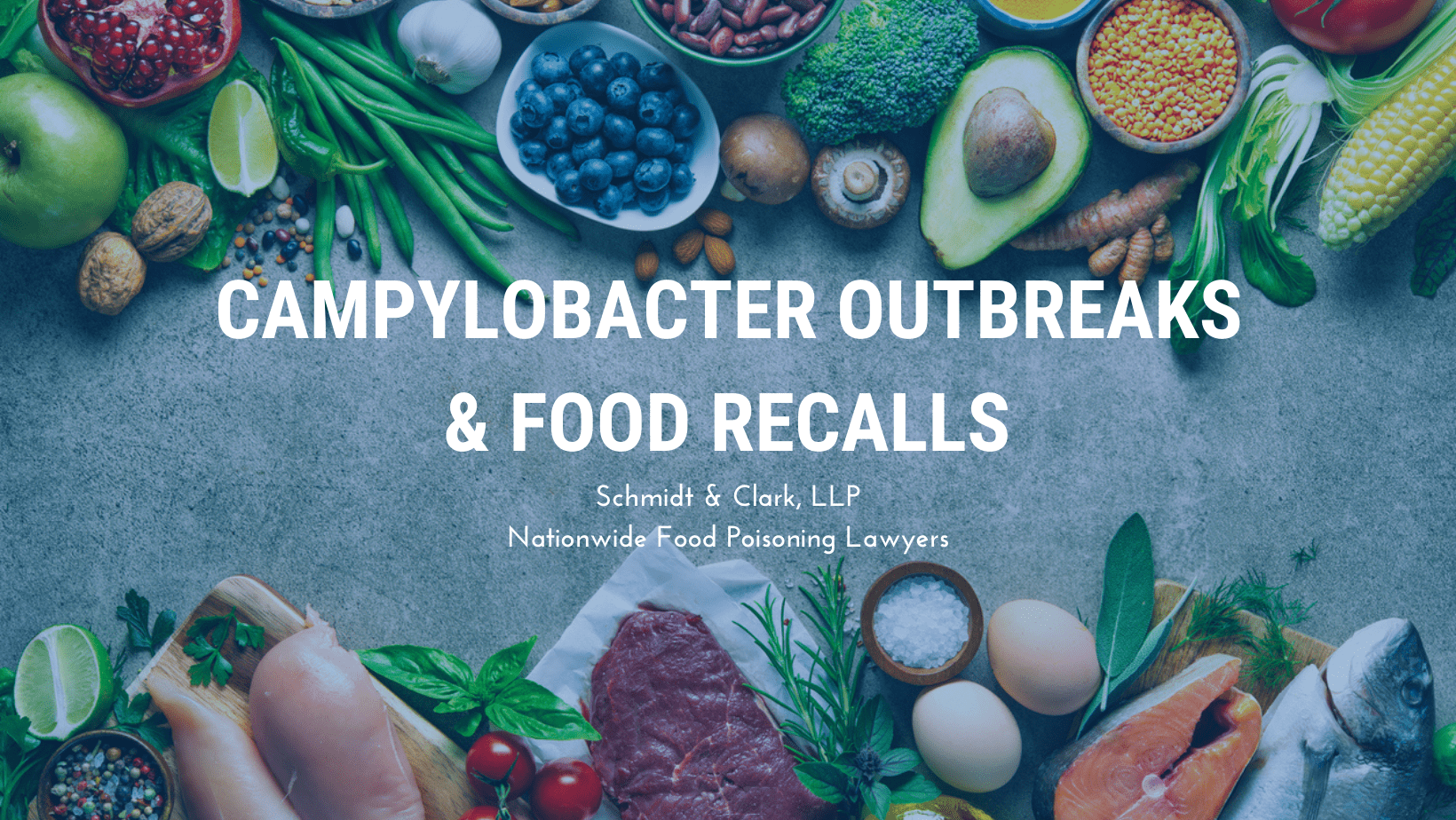You may be entitled to compensation by filing a campylobacter lawsuit and we can help. Please click the contact form below for a Free Consultation or call an attorney toll-free 24 hrs/day by dialing (866) 588-0600.
Table Of Contents
- Campylobacter Lawsuit Overview
- Latest Campylobacter Lawsuit Updates
- FDA Reports and Statistics
- Campylobacter Injuries & Side Effects
- Do You Qualify for a Campylobacter Lawsuit?
- Campylobacter Outbreaks
- Statute of Limitations for Campylobacter Lawsuits
- FAQs
- 1. What Are the Common Symptoms of a Campylobacter Infection?
- 2. How Is Campylobacter Transmitted to Humans?
- 3. What Foods Are Most Commonly Associated With Campylobacter Contamination?
- 4. How soon must I file a claim?
- 5. What evidence do I need to preserve?
- 6. Can I sue a restaurant?
- 7. What Are the Risk Factors for Campylobacter Food Poisoning?
- 8. How is Campylobacter Diagnosed?
- 9. What Happens if Campylobacter is Not Treated?
- 10. Can I Go to Work With Campylobacter?
- Get Your Free Campylobacter Lawsuit Evaluation From Our Lawyers
Campylobacter Lawsuit Overview
Campylobacter lawsuits are legal claims filed against food manufacturers, restaurants, or other entities responsible for food contamination that causes campylobacteriosis.
These lawsuits primarily allege negligence in food handling, preparation, or storage resulting in bacterial contamination.
The Centers for Disease Control and Prevention (CDC) estimates that at least 1.3 million food poisoning illnesses in the U.S. each year are caused by campylobacter, a bacterium that causes severe fever, bloody diarrhea, and cramps.
Campylobacter is the most common bacterial cause of foodborne illness in the United States.
Latest Campylobacter Lawsuit Updates
-
Ongoing: Litigation continues for Campylobacter-related Guillain-Barré syndrome and other neurological complications. Plaintiffs claim that Campylobacter infections have led to severe, life-altering conditions, including paralysis and long-term health complications [1].
-
February 2023: A lawsuit was filed after a Campylobacter outbreak at Wild Ginger Asian Fusion in New York, allegedly causing multiple foodborne illnesses among patrons. The lawsuit claims that improper food handling led to contamination, affecting customers with gastrointestinal issues.
FDA Reports and Statistics
According to the CDC and FDA MAUDE database reports, Campylobacter infections remain a significant public health concern:
- Approximately 1.3 million Americans are affected by Campylobacter infections annually.
- There are approximately 20 cases diagnosed per 100,000 people.
- The majority of cases go undiagnosed or unreported.
- Campylobacter infection rates increased by 12% in 2018 compared with 2015–2017.
- The FDA has reported over 2,500 adverse events related to Campylobacter contamination in the past three years.
- Approximately 8,500 hospitalizations occur annually due to Campylobacter infections.
Campylobacter Injuries & Side Effects
Campylobacter infections can range from mild to severe and may lead to serious complications, particularly in vulnerable populations.
- Emergency Symptoms: Severe, bloody diarrhea, high fever (102°F or higher), signs of dehydration (decreased urination, dry mouth, lethargy).
- Serious Symptoms: Persistent abdominal cramps, prolonged vomiting, fever lasting more than 3 days, bloody stools.
- Common Symptoms: Mild to moderate diarrhea, low-grade fever, nausea, mild abdominal discomfort.
- Long-term Complications: Guillain-Barré syndrome (paralysis), reactive arthritis, irritable bowel syndrome.
These food poisoning symptoms usually start 2 to 5 days after campylobacter bacteria contamination occurs and last about 1 week.
Most people recover without specific treatment. However, consult a healthcare provider if symptoms worsen or persist beyond a week. Be sure to stay hydrated and rest while recovering.
Do You Qualify for a Campylobacter Lawsuit?
You may qualify for a Campylobacter lawsuit if:
- You consumed food or beverages confirmed or suspected to contain Campylobacter bacteria.
- You experienced symptoms of Campylobacter infection within 2-5 days after consumption.
- You were diagnosed with Campylobacter infection through laboratory testing.
- You required medical treatment for your symptoms.
- You can demonstrate that your illness was caused by a specific food product or establishment.
Evidence Required for a Campylobacter Lawsuit
- Medical documentation: Records confirming Campylobacter diagnosis, stool sample test results. (before antibiotic use), and pulsed-field gel electrophoresis (PFGE) test results.
- Proof of consumption: Food purchase receipts, credit card statements, or restaurant records.
- Causation evidence: Health department outbreak reports (if part of a larger incident).
- Timeline documentation: Record of symptom onset (typically 2-5 days after exposure), all medical visits and treatments.
Damages You Can Recover
If successful in your Campylobacter lawsuit, you may be entitled to compensation for:
- Medical Expenses: Coverage for doctor visits, hospital stays, medications, and long-term treatment for complications.
- Lost Wages: Compensation for time off work during illness and reduced earning capacity due to long-term effects.
- Pain and Suffering: Compensation for physical discomfort and emotional distress during recovery.
- Long-term Complications: Damages for any lasting effects, such as Guillain-Barré syndrome, reactive arthritis, or irritable bowel syndrome.
Settlement ranges for Campylobacter cases typically vary from $1,000 for mild cases to over $1 million for severe cases with long-term complications.
Campylobacter Outbreaks
Campylobacter outbreaks have occurred in various settings, often linked to contaminated food or animal contact:2019: Pet Store Puppy Outbreak [2]:
- 30 people infected across 13 states
- 88% had contact with puppies
- 4 hospitalizations reported
- Linked to multidrug-resistant Campylobacter jejuni
2016–2018: Pet Store Puppy Outbreak [3]:
- 113 people infected from 17 states
- Linked to puppies sold through Petland stores
- Multidrug-resistant Campylobacter infections
2014: Raw Milk Outbreak (Utah) [4]:
- 99 infections in Northern Utah
- Ages 1-74 affected (median age 23)
- 65 patients reported severe abdominal pain
- Linked to raw milk from a single dairy
2012: Muddy Race Outbreak (Nevada) [5]:
- 22 Campylobacter infections (18 probable, 4 confirmed)
- Linked to obstacle adventure race on a cattle ranch
- Competitors fell face-first into mud or submerged in surface water
- Complications included fever, vomiting, and hemorrhagic diarrhea
2012: Chicken Liver Pâté Outbreak (Oregon) [6]:
- At least 4 people infected
- Linked to undercooked chicken liver pâté at 2 restaurants
- Livers sourced from same USDA-regulated establishment in Washington
2011: Guillain-Barré Syndrome Outbreak (US-Mexico Border) [7]:
- 26 cases identified (18 in Sonora, 8 in Arizona)
- 81% reported antecedent diarrhea
- 61% of tested patients positive for C. jejuni antibodies
- Linked to tap water
Treatment
Most cases of campylobacter food poisoning are mild and do not require professional medical treatment.
The contamination lasts 5 – 8 days and typically goes away.
In rare cases, abdominal illness can be serious and life-threatening. Severe health symptoms may respond to antibiotic treatment and anti-diarrheal medication may be administered to make the patient more comfortable.
Death from campylobacter food poisoning injury is more common when other diseases are present, such as liver disease or cancer.
Statute of Limitations for Campylobacter Lawsuits
The statute of limitations for filing a Campylobacter lawsuit varies by state, typically ranging from 1 to 3 years from the date of illness or discovery of injury.
It’s crucial to consult with an attorney as soon as possible after becoming ill to ensure your claim is filed within the legal timeframe.
Some states with shorter timeframes include:
- Tennessee: 1 year
- Louisiana: 1 year
- Kentucky: 1 year
States with longer timeframes include:
- Maine: 6 years
- North Dakota: 6 years
- Minnesota: 4 years
Acting quickly is important, as delays can jeopardize your right to seek compensation.
FAQs
1. What Are the Common Symptoms of a Campylobacter Infection?
Common symptoms include diarrhea, abdominal cramps, fever, nausea, and vomiting, typically starting 2-5 days after exposure and lasting about a week.
2. How Is Campylobacter Transmitted to Humans?
Campylobacter is transmitted primarily through undercooked poultry, contaminated water, or unpasteurized milk and can also spread through contact with infected animals or improper food handling.
3. What Foods Are Most Commonly Associated With Campylobacter Contamination?
Poultry products, particularly undercooked chicken, raw milk, and contaminated water, are most commonly associated with Campylobacter contamination, emphasizing proper cooking and handling.
4. How soon must I file a claim?
You must file your claim before the statute of limitations expires, which typically ranges from 1 to 3 years, depending on your state. Acting quickly is important, as delays can jeopardize your right to seek compensation.
5. What evidence do I need to preserve?
The evidence you need to preserve includes all medical records, test results, and documentation of symptoms, including the timeline of onset. Keep receipts, packaging, or photographs of the food, and note any communication with the food provider.
6. Can I sue a restaurant?
Yes, you can sue a restaurant if their negligence (such as improper food handling or sanitation) caused your Campylobacter food poisoning. You must demonstrate a direct link between the food consumed at the restaurant and your illness.
7. What Are the Risk Factors for Campylobacter Food Poisoning?
Risk factors include consuming undercooked poultry, raw dairy products, or contaminated water; direct contact with farm animals or pets; international travel; and poor kitchen hygiene that allows for cross-contamination.
8. How is Campylobacter Diagnosed?
Campylobacter is diagnosed when a laboratory test finds Campylobacter bacteria in stool, body tissue, or fluids through either a culture that isolates the bacteria or a rapid diagnostic test that detects genetic material.
9. What Happens if Campylobacter is Not Treated?
If untreated, Campylobacter may resolve on its own within a week, but some cases can lead to serious complications like Guillain-Barré syndrome, reactive arthritis, or irritable bowel syndrome. About 15% of individuals with Guillain-Barré syndrome remain wheelchair-bound one year after onset.
10. Can I Go to Work With Campylobacter?
You should stay home from work if you have symptoms of Campylobacter infection and can return only after being free from diarrhea for 48 hours. Food handlers and those working with vulnerable populations should inform their employers about the infection.
Get Your Free Campylobacter Lawsuit Evaluation From Our Lawyers
Time is limited to pursue legal action for Campylobacter food poisoning. Many states have a statute of limitations of only 1-3 years from the date of injury. Don’t wait until it’s too late to seek the compensation you deserve.
At Schmidt & Clark, LLP, we offer:
- Free, confidential consultations to evaluate your case
- No upfront costs or fees – we only get paid if you win
- Dedicated legal representation from experienced food poisoning attorneys
If you or a loved one suffered from Campylobacter food poisoning, contact us immediately for a free case review.
Call the food poisoning lawyers with Schmidt & Clark, LLP by dialing (866) 588-0600 or fill out the contact form below to get your free case review.
References
- https://pubmed.ncbi.nlm.nih.gov/11853315/
- https://archive.cdc.gov/#/details?url=https://www.cdc.gov/media/releases/2019/s1218-resistant-campylobacter-infections-linked-to-pet-store.html
- https://www.cdc.gov/mmwr/volumes/67/wr/mm6737a3.htm
- https://www.cdc.gov/mmwr/volumes/65/wr/mm6512a1.htm?s_cid=mm6512a1_e
- https://www.cdc.gov/mmwr/preview/mmwrhtml/mm6317a2.htm
- https://www.cdc.gov/mmwr/preview/mmwrhtml/mm6414a7.htm
- https://www.cambridge.org/core/journals/epidemiology-and-infection/article/binational-outbreak-of-guillainbarre-syndrome-associated-with-campylobacter-jejuni-infection-mexico-and-usa-2011/0025D4F0032C647E79AD4854F2045ABA

 Published by
Published by 


